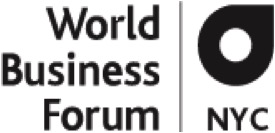“Play ball!”
Yes, baseball season is now upon us and that familiar game-opening refrain will be heard in stadiums near and far.
Which got me thinking about great players, which got me thinking about how great players remain great
Commitment
Why You Should Sweat the Details
Hosain Rahman, the CEO of Jawbone, design celebrity Yves Béhar, and a Jawbone executive met to discuss the packaging for a product. The specific issue: Did they have the right color of black?
How To Start The New Year Off Right
It was Socrates who said that to move the world we must first move ourselves. So with the New Year upon us, and the world at your feet, what are you doing to move yourself?
My Big Takeaways From the World Business Forum
Just got back from the World Business Forum in NYC. Two days listening to some very accomplished people in a range of fields. Stimulating, inspiring, cool.
Walter Isaacson, author of the acclaimed Steve Jobs biography, had this insight: “Innovation stands at the intersection of the humanities and technology.”
Carolyn Everson of Facebook showed us the future: “Mobile and video isn’t about marketing, it’s about your business model.” She added, “It’s critical to be a listening organization, and listening organizations breed curiosity, empathy, and collaboration.”
Mark Bertolini, CEO of Aetna, warned against “the terrorism of the spreadsheet” with which decisions are made without any consideration of the human and cultural implications.
Herminia Ibarra of INSEAD had this provocative thought: “Don’t change how you think to change how you act, change how you ACT to change how you think.”
Stephen Ritz, who’s working miracles with students in the South Bronx (GreenBronxMachine.org), turned the “Serenity Prayer” on its head: “I’m not willing to accept the things I can’t change. I want to change the things I can’t accept.”
And two-time Oscar winner Kevin Spacey reminded us: “Stories are the substance of our experiences. Because of technology, there’s never been a better moment to tell vivid stories.”
Go tell your story!
Your thoughts?
Michael
Are You All-In or Just All Talk?
Today, customers and employees have little patience for organizations that trumpet what they stand for but fail to live up to it. And they’re shifting to organizations that do.
Outdoor clothing company Patagonia actively promotes their concern for the environment. So do they walk they talk? Ten years ago, founder Yvon Chouinard gave the company 18 months to stop using industrial-grown cotton, which was the most environmentally damaging fiber they used. Even though 25% of their $250 million in revenues came from products made from industrial-grown cotton! And they did it.
More recently, they’ve made a commitment to “Traceable Down” to ensure the highest standard of animal welfare in the industry. They trace their down from the parent farms to the apparel factories to verify that none comes from geese that have been force-fed or live-plucked, or is blended with down from sources they can’t trace.
Is it surprising that customers and employees are flocking to Patagonia? (Pun absolutely intended!)
What does your organization stand for? And are you all-in or just all talk?
Your thoughts?
Michael
The Talent Management Practice We Too-Often Avoid
Growing companies recognize the importance of onboarding – providing new employees with the knowledge, skills, expectations and support to become effective contributors. Yet they often avoid an equally important talent management practice.
Off-boarding.
I have a client company that is poised for strong growth over the next few years. They now understand that if they don’t hold their people constructively accountable – ultimately removing those who can’t or won’t meet expectations – then they aren’t likely to realize that growth.
How do you hold people constructively accountable? By giving them candid feedback about their performance and conduct. By conveying clear expectations, and the “why” behind those expectations. By providing coaching and encouragement. By letting them know there are consequences if expectations don’t get met. And finally, once all reasonable steps have been taken, by removing the employee from the organization.
What is the consequence of managers not holding people accountable? They destroy their credibility, demotivate their people, and undermine their organization.
Onboard people to help them meet expectations. And off-board those who don’t.
Your thoughts?
Michael
Responsible Leadership: It’s Easy to Lead if …
(This is the 4th and final blog in a series about John Race, mountain guide and co-owner of Northwest Mountain School, who recently led two of my nephews and me up Mt. Baker in Washington State.)
John, like every mountain guide, is a leader. Yet unlike other leaders, in his job he leads clients. And John believes it’s easy to lead if you have …
1) The Right Passion: He had a love for climbing well before he started his business
2) The Right Background: Over a number of years he earned his International Mountain Guide certification, attesting to his skills, knowledge and experience
3) The Right Mindset: His number one focus is always on his clients and their needs
4) The Right People: Although it’s challenging to pre-qualify clients, it’s much easier to lead those who are positive and capable than those who aren’t
You’re a leader. Do you have a passion for what you do? Do you have the right background? How about your mindset? And are you leading the right people?
When all is said and done, how easy is it for you to lead?
Your thoughts?
Michael
What Personal Trainers Know About Change
Do you remember Brad Pitt in the movie, Troy? How about Chris Hemsworth in Thor? How did those guys get to be so muscular?
Duffy Gaver is a personal trainer who transforms celebrities’ physiques. And it’s serious business. He has no interest in toning muscles (whatever that means); he doesn’t rely on new-age nutritional products … he has a very simple philosophy. And it applies to organizations as well as it does to individuals.
Discomfort is where all of the change takes place.
Read that again and let it resonate.
There can be no change without discomfort. Embrace it. Anticipate and embrace the discomfort that is necessary for positive change. It’s what success should feel like.
Your thoughts?
Michael
What True Commitment Looks Like
How committed are you to winning? To executing your plans? To achieving your goals?
I’ve asked the winning question to thousands of organizational leaders and the overwhelming response is “100%.” They’re totally committed.
Are they?
All of us limit ourselves with false ceilings. We underestimate what we are capable of and what true commitment looks like.
Tommy Caldwell and Kevin Jorgeson are elite rock climbers who recently completed what one magazine dubbed, “The Climb of the Century.” They free-climbed the seemingly impossible Dawn Wall, a massive rock face on El Capitan in Yosemite National Park. To us mortals, the wall appears to have about as many foot-and-handholds as a 3,000-foot plate of glass. Yet Caldwell and Jorgeson climbed it … and it took nineteen days! (http://www.climbing.com/dawn-wall-interviews/)
Now that’s commitment.
Or so you might think. The real commitment was actually in the years they spent dangling from ropes and studying the wall with magnifying lenses to find the holds that might make an ascent possible. It was in the years of practice, sequencing the moves that made up each of the 32 pitches. And it was in the years they spent on logistics and strategy, determining how fast to climb – or not, where to pre-stash supplies on the wall, and how they might receive supplies. This wasn’t just nineteen days; this was a seven-year project.
Now that’s commitment.
You’re an organizational leader. Maybe you don’t have to be as committed as a Caldwell or Jorgeson. But ask yourself if you are as committed as you should be.
Your thoughts?
Michael
Cultivate This … It’s More Powerful Than Discipline
Being disciplined is a trait I admire. Many would say I’m very disciplined, but I don’t think I’m disciplined nearly enough (something, apparently, that many disciplined people say!).
So I was intrigued when a friend told me about a book she was reading, The Power of Habit by Charles Duhigg. The simplified premise, as you might guess, is that one’s power lies in the ability to cultivate positive habits.
Which got me thinking about the relationship between habit and discipline.
Discipline implies making a conscious decision and then applying one’s will to follow-through on that decision. Going to the gym. Turning down that piece of chocolate cake.
Yet when something becomes a habit, there is no decision to be made and, as a result, no will that needs to be applied. The issue of choice doesn’t enter the picture. My friend, who I consider to be very disciplined, says that running every day – something she has done for many years – is simply a habit, not a result of iron-willed discipline.
Now, we often talk about successful organizations being disciplined. Are they disciplined or is it they’ve cultivated good habits? And should we place more focus on building such habits?
Still, it’s not to say that discipline plays no role in success. After all, how do you think individuals and organizations build good habits?!
Your thoughts?
Michael
Why Alignment is Critical to Execution, Despite What HBR Says
The esteemed business publication, Harvard Business Review, publishes an article in its March edition about why strategy execution breaks down. The authors debunk so-called myths about execution including the myth that execution equals alignment.
Now, as a long-time proponent of ruthless consistency and organizational alignment, you can imagine my interest was more than just a bit piqued.
It turns out the authors’ conception of alignment is limited to HR practices such as developing objectives, measures and rewards that are consistent with strategy. Sorry guys, there‚Äôs far more to alignment than that.
Organizational alignment is the idea that people, processes, structure and infrastructure all need to be consistent with an organization’s strategy. The right measures don’t keep the wrong processes from failing. The right rewards don’t help if the right boxes aren’t on the org chart. Any critical factor misaligned can cause execution to fail.
The authors go on to identify the lack of coordination across functions or units as a major cause of failure. True. Yet that doesn’t argue against organizational alignment, that is organizational alignment.
So, yes, alignment is critical to execution. And it means much more than simply goals, measures and rewards.
Your thoughts?
Michael
When is it time for a CEO to move on?
John Montalbano didn’t like it, but it was the right thing to do. As the CEO of RBC Global Asset Management – Canada’s largest asset-management firm – he announced that he would be stepping down.
No, it didn’t have to do with poor results – RBC Global Asset Management has consistently been rated at or near the top of its category. And it didn’t have to do with falling out of touch – Montalbano was just 50. It had to do with a belief.
“After analyzing thousands of companies as a fund manager and as an analyst, I came to a view that CEOs have a due date of eight to 10 years. After that, they either become stale or start to close doors for people around them who are ready to step forward.”
“It didn’t feel good, but it felt right. To me, that’s how leaving should feel: it can never be about you; it’s got to be about your business.”
It can never be about you; it’s got to be about your business. Knowing when to step aside is just as important as knowing when to take the reins.
What’s best for your organization?
Your thoughts?
Michael












